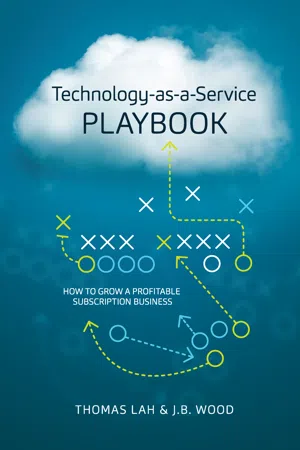
Technology-as-a-Service Playbook
How to Grow a Profitable Subscription Business
- 349 pages
- English
- ePUB (mobile friendly)
- Available on iOS & Android
Technology-as-a-Service Playbook
How to Grow a Profitable Subscription Business
About this book
Technology-as-a-Service Playbook defines the tactical and strategic plays technology companies must run to build a profitable subscription business. Whether you are a pureplay cloud company or a traditional technology provider making the pivot to the cloud, this book will help guide your decision-making and execution around the "as-a-service" model to put your company on a path to profitable growth.
This cloud-driven journey will affect every part of the organization. How offers are designed, built, marketed, sold, and serviced will all need to change. And these transformations are not limited to OEMs—they will also directly impact the vast network of channel partners. After all, it's not just about building recurring revenue, it's about building PROFITABLE recurring revenue. Technology-as-a-Service Playbook is the road map to the next-generation tech business model.
Frequently asked questions
- Essential is ideal for learners and professionals who enjoy exploring a wide range of subjects. Access the Essential Library with 800,000+ trusted titles and best-sellers across business, personal growth, and the humanities. Includes unlimited reading time and Standard Read Aloud voice.
- Complete: Perfect for advanced learners and researchers needing full, unrestricted access. Unlock 1.4M+ books across hundreds of subjects, including academic and specialized titles. The Complete Plan also includes advanced features like Premium Read Aloud and Research Assistant.
Please note we cannot support devices running on iOS 13 and Android 7 or earlier. Learn more about using the app.
Information
| 1 | Disruption Happens |
- The ability to “prove deliverable business outcomes’” will supplant “win the feature bake-off” as the central focus of senior leadership at tech companies. This will cause a dramatic re-thinking of investments and top talent allocation. Offers will “go vertical” in order to better deliver full value to the customer. Services will move from the back of the bus to the front of the bus. But at the same time …
- Software will eat services. The ability of technology companies to reduce technical complexity and build best customer practices into their software will be a defining characteristic of successful XaaS providers. Value-added services will survive and prosper as a concept. However, labor-delivered services (except highly consultative expertise) will still be viewed by management as a boat anchor. Eventually, development will accept that their charter includes the “full product” and not just a collection of features. They will build all the capabilities into the product that are needed not only to win the feature bake-off but also to enable the differentiated services that will drive adoption, encourage expansion, reduce sales costs, and have a plethora of other objectives. These are the capabilities needed to create downstream profits and sustained competitive advantage.
- Suppliers and customers will increasingly compete as every company becomes a tech company. Low-cost software development will turn industrial buyers of technology into technology producers themselves. Technology resellers will find their original equipment manufacturer (OEM) suppliers competing with them through cloud-enabled, direct models. Large XaaS providers will manufacture their own hardware and build their own software, no longer being a buyer of technology but actually overseeing the manufacture of the products they use. (By the way, all of this is already happening at scale.)
- The act of selling will undergo radical change. Customers can now self-serve a huge amount of the information they need to make a technology purchase decision. They will be able to self-serve on simple purchasing decisions like low-cost XaaS trials or renewals. Even on more complex decisions they will have less and less interest or patience for “company overviews” or “demos” from their sales rep. They will know all that. They will want to discuss the “last mile.” They will want to know specifically how your key features will lead to improved business outcomes for companies in their specific industry. Selling will become a process, not a heroic act!
- Delivering and measuring customer success will become a defining characteristic of market leaders. If you don’t have a systematic way to make more than 90% of all your XaaS successful, you will not be profitable. We are not just talking about success in your terms; we are talking about success in the customer’s terms.
- Organizational structures will be significantly reinvented with highly integrated development, marketing, sales, finance, and service teams swarming around specific customer segments. Regional autonomy over international markets will decline, and centralized processes and systems will ascend. Even traditional departmental profit and loss statements (P&Ls)—the archaic command and control systems we dearly loved—will collapse under the weight of the new operational and organizational models, where expense dollars in one department yield revenue growth or cost savings in a totally different department.
- Channel partner models will get re-thought and reconstructed. Many resellers will perish in the transition. New kinds of partners will be added. How the OEM and their partners work together for a particular customer will be radically redefined as the old notion of direct or indirect customers is replaced by a model where bo...
Table of contents
- Cover Page
- Title Page
- Copyright Page
- Contents
- 1. Disruption Happens
- 2. The 3x3 of XaaS
- 3. Digging an Economic Moat for Your XaaS Business
- 4. Stressing Traditional Organizational Structures
- 5. Swallowing the Fish
- 6. The Power of XaaS Portfolios
- 7. XaaS Customer Engagement Models
- 8. The Financial Keys of XaaS
- 9. The Case for Managed Services
- 10. Changes in the Channel
- Endnotes
- Index